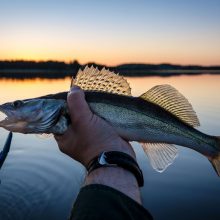This article may contain affiliate links. If you make a purchase after clicking on a link we may earn a small commission at no extra cost to you. As an Amazon Associate, I earn from qualifying purchases.
Trolling for Walleye – How to Guide

During the winter and early spring months most walleye fishing usually involves a jig or bait.
However, once the spawning season ends and the temperatures begin to rise your focus should turn to trolling. The best walleye lures for trolling will be crankbaits, spinners, small flatfish lures and Rapala’s.
Walleye trolling is much like other trolling for other freshwater species like salmon or lake trout except the gear may be slightly lighter and you may use a hybrid rig like a crawler harness.
Traditional trolling rigs for walleye are just as effective as a harness. But in the early season when you need to slow things down a bit a harness allows you to troll at super slow speeds.
Trolling for Walleye
Trolling for walleye consists of trolling one of the following setups behind a boat usually in conjunction with a fish finder to help determine the depth:
- Crawler harness
- Crankbaits
- Rapala’s
- Spinners and spoons
The types of lures you choose will vary depending on the time of year and the depth at which you are trolling.
Crawler harnesses in the late spring and early summer and then larger crankbaits such as Rapala’s Shad Rap in the summer.
Spinners and trolling spoons for walleye can be used at speed in the summer but spinners are most effective when used as part of a crawler harness at slower speeds when walleye are feeling lazy.
Smaller light lures such as walleye jerkbaits can also be trolled but to get the best performance from them you will need to twitch the rod tip and troll with rod in hand.
Walleye tend to love structures so best to start there and if it is not producing you an head for more open water.
In deeper open water walleye can start to school in smaller groups hitting one of these schools can be a little bit hit and miss.
Weed beds, drop offs and other sub-surface structures and features should always be your first choice.
Once you find them at these structures try to make long sweeps along the structures rather than directly over them.
Walleye Trolling Speed
The best trolling speed for walleye will fall somewhere in the range of 0.5 to 3 mph. It will of course depend on a number of factors such as:
- Season
- Type of lure
- Depth
During late spring and into the early summer your speed will need to be on the slower side. Walleye are often quite lazy following their spawning season and as a result are less inclined to chase a lure that is moving too fast.
Once the warmer summer days arrive walleye will tend to feed in a much more aggressive manner. There is also a lot more food on offer.
Once they are done with spawning you can start to use lures that require a slightly faster speed to get the best action out of them.
When trolling larger crankbaits you can troll at the higher end speeds up to around 3 mph.
However, most walleye crankbaits will perform best at around the 2 mph mark.
Walleye Trolling Tips
Although there are a lot of fishermen who will just tie on a crankbait let out lots of line and hope for the best this really is not the best approach to catching walleye from a boat.
You need to stop and think about some of the factors already mentioned above, some walleye trolling tips to follow:
- Season can determine your trolling speed
- Use a fish finder to find the walleye
- Pay attention to the contours of the bottom
- Cover as much ground as you can
- Change your speed
- Move the boat in an ‘S’ pattern
Walleye Trolling Setup
The type of walleye tackle required for trolling is a lot different to when you are jigging.
If you are using more than two rods on your boat then you may need to use planer boards to get keep the out side lines as wide as possible from the inner lines.
To get to the desired depth you can control your lure by adding weight to the line. There are usually two options used when using weight whilst trolling:
- Bottom bouncing
- Three way rig
Both require a little experimentation to get the desired depth just right.
If your budget allows for it you can of course invest in a downrigger.
A downrigger allows you to get a much more accurate running depth for you lures.
But a downrigger can require the use of a heavier rod as the constant strain is likely to ruin a lighter rod.
